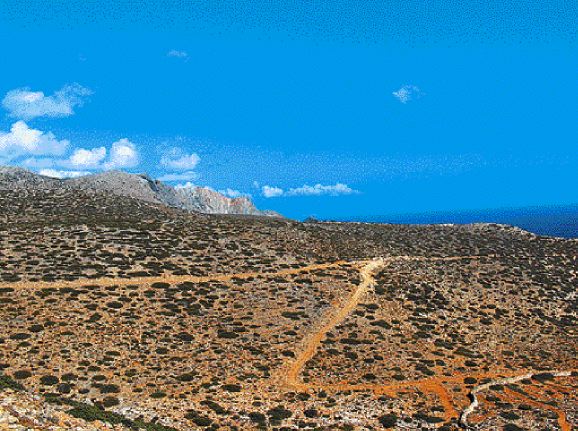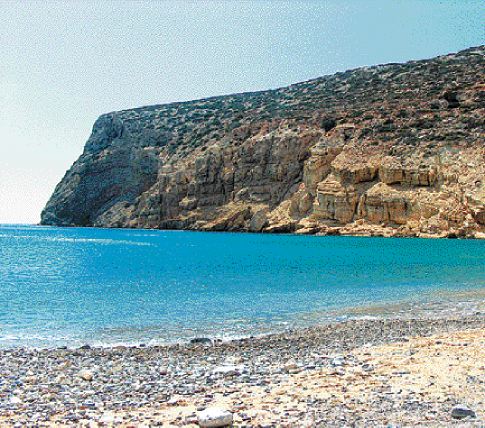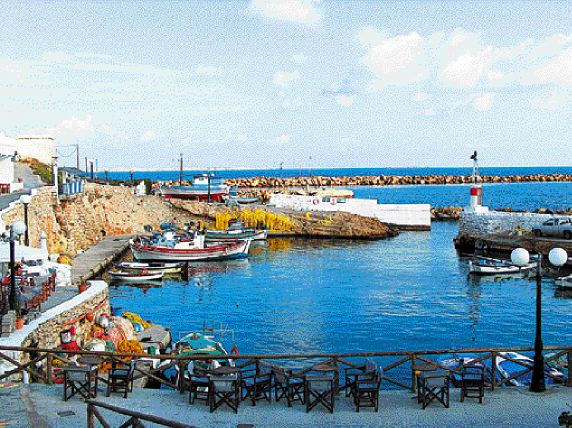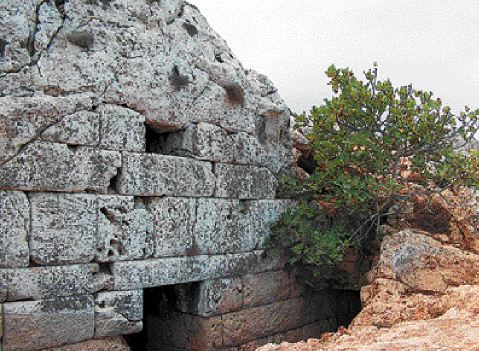 |
||
|
Curious Kasos Attracts Few Visitors
|
||
|
This small Dodecanese island has few tourist facilities, a lot of elderlyresidents, a phantom economy and frequent flights. It's all a bit bizarre By Jonathan Carr Athens News |
 Kasos' rocky terrain |
|
There are advantages in going to a place where you're not really expected. For a change, there are few choices to make and nobody is trying to sell you anything. In fact, there's hardly anyone at all to be seen here at Kasos airstrip where I have just arrived as the island's one new tourist of the day in the very comfortable, fully-staffed, 50-seater Olympic Airways (OA) plane. It has flown me here from Rhodes via neighbouring Karpathos, along with one local family of three. The cost was 28 euros. Since there is nothing else to do, we all stand in the sun and scrutinise the completion of baggage handling procedures. Three items, correctly labelled, are heaved out of the aircraft's hold and into the OA van for transfer to the terminal. I wonder whether they will do a quick circuit of the airstrip to make it a bit more of a show for us, but no, five seconds later, here they are. What now? Are there any taxis? I ask my fellow passengers. There are in general, they tell me, but there don't seem to be any in particular. So they offer to take me into town themselves. The truth, though, is that I could have walked. The island's capital of Fry (pronounced Free) is only about a kilometre away along the coast. Bit of an odd place, Kasos. I'm still not sure what to make of it. there seems to be only one place to stay, which is the disadvantage of being a rarity. Prices have that tendency to climb. Even at the best of times, if you can call August the best of times, estimates of how many rentable beds are available on the island don't seem to go above 180 - and that number may well have a significant machismo factor in it. And the population? Probably around 800. But for how long? Walking around town is like taking part in an experiment. What happens if you create a community where people never stop working? I mean, never. The lady who serves coffee at the Mathaios Kafeneio overlooking the town's old port of Bouka is tiny and almost bent double, can hardly see me, recites verse on the job and if she's not in her nineties I'll eat my cap. Over at the fruit-and-veg store and the bakery, things are not much better and at the nearby zaharoplasteio I might concede it's a seventy-going-on-eighty-year-old who insists on giving me free cakes while we wait for some cheese pies to get delivered. Of course, there are a lot of old men sitting around arguing over coffee but my guess is that they might also do a bit of work sometimes when nobody's looking. Perhaps I have walked into a fable? Maybe this is that mythical country of old people? |
||
Yes, this is hyperbole. Of course, there is some young blood too. But not much. And there must be a serious concern that one day the population level will dive, as it has so often in the past - on occasion into nothing at all. In outline, it's a familiar Greek island story. Recorded history begins with Homer and Kasos' mention in the Iliad alongside Karpathos, its much bigger and only real neighbour whose fortunes it will often share. It pops up as a contributor of 1,000 drachmas to the Athenian Alliance during the Persian wars; apparently it keeps out of Alexander the Great's campaign, joins the Roman empire and then comes under Italian city state rule, first from the Genoese and then the Venetians. We know the Knights of St John made only the shortest of stopovers in Karpathos - and thus presumably Kasos too - from 1311 to 1315. Not enough time to leave any castles behind, as in the rest of the Dodecanese. Turkish control comes next, followed by the Italians in the first half of the 20th century. |
 Dizzying hairpin bends leads to the stoney beach of Chelatros |
|
| The economic story is no surprise either. A once-thriving industry, in this case shipbuilding, collapses; people emigrate and a society falls apart. But Kasos is different from other islands in two respects. First, it is still haunted by the events of a single day in the 19th century. Second, it does not rely much on tourism. 1824 One of the first things you see on arrival in Fry at the new harbour, an enormous and ugly spread of concrete that seems just a touch over-ambitious for the island's needs, are the numbers written in white stones on the hillside opposite 1824. A monument a few kilometres on the other side of town, past what is referred to - also ambitiously - as the local beach (it is no more than a surprise sandbank) repeats the date. What happened was this. |
||
When the Greek fight for independence began in 1821, Kasos provided an impressive 22 ships and 60 support vessels which were used to raid nearby islands and the coasts of Egypt and Syria. This aggravated Mohammed Ali, the Turkish governor of Egypt, who wanted to set up a base on Crete before attacking the Peloponnese. So he decided on Kasos' elimination. On 27 May 1824, ex-pirate Ismail Gibraltar arrived with 45 ships off the Kasos coast. Fighting went on for some days. The decisive moment came on June 7 when over 1,000 enemy troops, perhaps tipped off by a traitor, made landfall. All men of arms-bearing age were killed. Surviving women and children were taken to Egypt as slaves. Houses and farms were burnt. On June 7, every year, the dead of 1824 are remembered. It is hard to imagine how recovery takes place after something as catastrophic and final as this. But it did. There must have been a few survivors and, presumably, some residents were not on the island at the time. Repopulation took place to such an |
 The old port in Fry |
|
| extent that by 1845 the island had 75 ships, according to the story told in Fry's interesting little museum. But shipbuilding, in the industrial age, was not what it was. Emigration began, ironically, to Egypt to help build the Suez Canal. Later, people would leave for the USA. It's a pretty safe bet that they're still leaving. |
||
|
Tourist options
So what is there to do on an introspective island out of high season? Not a whole lot is the honest answer. If you do want to 'do' something, there are only two choices. This is not an either/or decision, just a first/second. You can tour the island and you can visit an archaeological site. I toss a coin. Touring comes first. To tour, you can either go east or southwest. I toss a coin. It's southwest first. It is not far to the end of the island - overall, Kasos is only about 16 by 6 kilometres. A road cuts through some fairly desolate and mountainous terrain and drops, via a dizzying number of hairpin bends, to Chelatros - the only place here that really qualifies as a (stony) beach. There are allegedly "dreamlike" sandy beaches on two uninhabited islets to the north - Armathia and Makra - but encountering them is a high season-only option. Down at sea level there is nobody and nothing to be seen apart from an old boat pulled up on the shore. I potter about and on the way back set myself the target of walking across the hillside to a church called Agios Georgios Chadies. In terms of solitude and landscape, Kasos is beginning to grow on me. |
 Hellenistic walls of rock shelter dating back to 425-375BC at Ellinokamara, the only archaeological site on the island |
|
Next it is time to go the other way - east. As usual in Greece these days, new roads lead to old churches. And old churches, of course, always lead to good views. This time the tarmac strikes out uphill to what used to be the monastery of Agios Mamas, famous locally for an entrepreneurial 19th-century character called Kalogeros Christopheros. He seems to have been a monk-of-all-trades - builder, doctor, icon painter, school founder... No monks are here now. In fact, nobody is here at all. It's that sort of day. Or, rather, it's that sort of island. Of course, there are people, but they're all getting on with the business of living rather than looking. And there is a limit to how much a visitor either should or can get a taste of island life without putting in some time and effort. Being a voyeur in a village not expecting visitors can be quite a refreshing experience. You're the oddity, rather than the other way round. To the south of Fry there are some villages - Arvanitochori, Panagia and Poli - which are very much lived in. And to the southwest is one more village, Agia Marina, through which you will have to pass to exercise your second tourist option - visiting the only archaeological site on the island of significance - Ellinokamara. Exactly what its significance was, though, remains a matter of speculation. The structure is quite well hidden in a small hill to the south of the village. Huge limestone blocks that, according to information in Fry's museum, were erected in about 425-375BC support the entrance to a cave. The stones blend neatly into their rocky surround. You go down some steps, stoop and enter and then go up some steps, stoop and stare. Daylight streams in from above in two places and, as your eyes adjust, you will get a feel for just how extensive the cave is. The atmosphere, even without an accompanying story, is palpable. Some kind of structure that looks as though it might have been an altar still stands; carved columns lie broken in the dust. Worship, sacrifices, rites of passage, orgies...they could all have happened here and probably did. It was a place of survival too. According to one islander, women and children were confined here for days on end during the troubles of 1824. They came through the ordeal because there was a water source in the cave. Unreality I spend my last few hours on Kasos wandering round Fry, trying to work out how I feel. Normally, I don't find it so difficult. But this really is a curious place. There's nothing stunning to see either on the island or around town. It can't be recommended in that sense. But there is an authenticity to things that is so often missing on Greek islands. Or is there? Perhaps this is just an illusion. Because what we almost certainly have here is a phantom economy that may seem to be based on traditional fishing and agriculture rather than tourism, but which really depends on dollars sent over by Kasos' US-based expatriate community. Not that there's anything wrong with this. But it may not last. One day there may not be enough people to take over from all those astonishing old folk who still get up every morning to work. There is an air of unreality about the place. Is Kasos lost in a time warp, still in recovery from the traumas of the past? Is it in denial over a pretend economy? Or have I strayed into a gerontic myth? I can't decide. And I've run out of time. Here is the 50-seater Olympic Airways plane coming back again, as it does once a day, sometimes twice. This time we are a hefty six passengers. Five residents and Kasos' one departing tourist for the day. How to get there Photos by Jonathan Carr |
||
|
|
||
(Posting Date 13 July 2006) HCS readers can view other excellent articles by this writer in the News & Issues and other sections of our extensive, permanent archives at the URL http://www.helleniccomserve.com./contents.html
All articles of Athens News appearing on HCS have been reprinted with permission. |
||
|
||
|
2000 © Hellenic Communication Service, L.L.C. All Rights Reserved. http://www.HellenicComServe.com |
||

